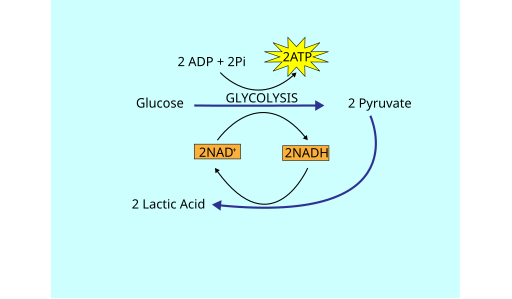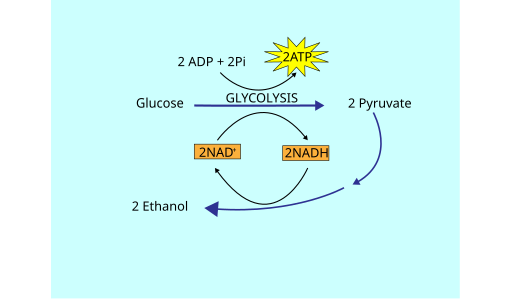OCR Specification focus:
‘Compare anaerobic respiration in mammals and yeast, benefits of anaerobic pathways, and why ATP yield is lower; investigate rates in yeast aerobically and anaerobically.’
Anaerobic respiration enables organisms to produce limited ATP when oxygen is unavailable, sustaining essential metabolic processes in cells of mammals, plants, and microorganisms under hypoxic conditions.
The Nature of Anaerobic Respiration
Anaerobic respiration occurs in the absence of oxygen, allowing the continuation of ATP production through glycolysis. This process is essential when oxygen supply cannot meet the cell’s energy demands, such as during intense exercise or in oxygen-deprived environments.
The Role of Glycolysis
Under anaerobic conditions, glycolysis remains the only source of ATP. In this pathway:
Glucose is phosphorylated and converted into two molecules of pyruvate.
Net gain: 2 ATP molecules per glucose molecule.
Reduced NAD (NADH) is generated when triose phosphate is oxidised.
To prevent glycolysis from halting, NAD must be regenerated from NADH, as NAD acts as a coenzyme required for the oxidation of triose phosphate.
Anaerobic Respiration in Mammals
In mammals, anaerobic respiration occurs mainly in muscle cells during vigorous activity when oxygen delivery is insufficient for aerobic respiration.
The Lactic Acid Pathway
Pyruvate acts as the hydrogen acceptor, accepting hydrogen from reduced NAD, forming lactate (lactic acid) and regenerating NAD.
The reaction allows glycolysis to continue, maintaining ATP supply.

Lactic acid fermentation in mammalian muscle reduces pyruvate to lactate, oxidising NADH to NAD⁺ so glycolysis can proceed and yield ATP without oxygen. The diagram labels substrates and products with directional arrows for the single enzyme step. Any extra context beyond the syllabus is minimal and limited to a brief note that fermentation maintains glycolysis. Source.
Key enzyme: Lactate dehydrogenase catalyses the conversion of pyruvate to lactate.
Over time, lactate accumulates in muscles, causing muscle fatigue and pH decrease due to lactic acid. When oxygen becomes available again, lactate is transported to the liver, where it is converted back into pyruvate for oxidation in aerobic respiration or for gluconeogenesis (formation of glucose).
Advantages of anaerobic respiration in mammals:
Allows continued ATP production during oxygen shortage.
Prevents immediate cell death during short-term anaerobic stress.
Limitations:
Produces only 2 ATP per glucose molecule.
Lactate accumulation leads to acidity and potential enzyme inhibition.
Anaerobic Respiration in Yeast
Yeast (a unicellular fungus) carries out a different form of anaerobic respiration, known as alcoholic fermentation.
The Alcoholic Fermentation Pathway
Pyruvate is first decarboxylated to ethanal by the enzyme pyruvate decarboxylase.
Ethanal then acts as the hydrogen acceptor, being reduced by reduced NAD to form ethanol (alcohol) and regenerate NAD.
Overall reaction:
Glucose → Ethanol + Carbon dioxide + ATP

Alcoholic fermentation in yeast decarboxylates pyruvate to ethanal (acetaldehyde), then reduces it to ethanol, regenerating NAD⁺ to sustain glycolysis. The figure clearly marks the two enzyme-catalysed steps (pyruvate decarboxylase and alcohol dehydrogenase) and the release of CO₂. Extra detail is limited to coenzyme flow and step arrows consistent with A-level expectations. Source.
Key enzymes:
Pyruvate decarboxylase
Alcohol dehydrogenase
Industrial importance:
Basis for brewing, wine-making, and baking, where carbon dioxide causes bread to rise and ethanol provides alcoholic content in beverages.
Advantages for yeast:
Enables survival in anaerobic or sealed environments.
Regenerates NAD to sustain glycolysis and ATP production.
Limitations:
Ethanol is toxic at high concentrations, inhibiting enzyme activity and restricting yeast growth.
Comparison of Anaerobic Respiration in Mammals and Yeast
Both mammalian and yeast anaerobic respiration regenerate NAD so glycolysis can continue, but they differ in products and reversibility.
In mammals, pyruvate is reduced directly to lactate without CO₂ release, and lactate can later be oxidised aerobically.
In yeast, pyruvate is converted first to ethanal, releasing CO₂, and then to ethanol; the process is irreversible because ethanol cannot be reconverted to pyruvate.
The Energy Yield of Anaerobic Respiration
Anaerobic respiration produces significantly less ATP than aerobic respiration.
EQUATION
—-----------------------------------------------------------------
ATP yield comparison = Energy output per glucose
Aerobic = ~38 ATP molecules
Anaerobic = 2 ATP molecules
—-----------------------------------------------------------------
This difference occurs because oxidative phosphorylation in the electron transport chain requires oxygen as the final electron acceptor. Without oxygen, only substrate-level phosphorylation in glycolysis produces ATP.
The lower ATP yield limits the energy available for sustained activity, explaining why anaerobic respiration can only support short-term energy demands.
Benefits of Anaerobic Pathways
Despite the low energy yield, anaerobic respiration offers several benefits:
Survival in anoxic conditions: Enables organisms to live in environments lacking oxygen.
Rapid ATP supply: Provides quick energy during sudden increases in demand.
Temporary energy continuity: Prevents energy crises when oxygen transport or availability is impaired.
For example, during intense exercise, muscle cells rely on anaerobic respiration to maintain ATP production, while in yeast, fermentation ensures energy production in sealed or oxygen-limited containers.
Investigating Anaerobic Respiration in Yeast
The rate of anaerobic respiration can be investigated experimentally using yeast cultures under controlled aerobic and anaerobic conditions.
Experimental Setup
A respirometer or gas syringe can measure carbon dioxide production, indicating the rate of respiration.
Glucose solution provides the substrate, and yeast suspension supplies the enzymes and coenzymes.
Anaerobic conditions are achieved by sealing the vessel or adding a layer of liquid paraffin to prevent oxygen diffusion.
The rate of CO₂ evolution is compared between aerobic and anaerobic setups.
Variables to control:
Temperature (often maintained at 35–40°C for optimum enzyme activity)
Glucose concentration
pH and yeast concentration
Indicators of rate:
Faster CO₂ production reflects a higher rate of anaerobic respiration.
No CO₂ in mammalian anaerobic respiration, so in mammals, lactate concentration could be monitored instead.
Interpretation:
Under anaerobic conditions, CO₂ and ethanol accumulate, confirming fermentation.
Under aerobic conditions, respiration yields more ATP, less ethanol, and sustained yeast growth.
Summary of Key Terms
Anaerobic respiration: The partial breakdown of glucose in the absence of oxygen, producing a small yield of ATP and organic by-products such as lactate or ethanol.
Fermentation: An anaerobic metabolic pathway in which organic molecules act as both electron donors and acceptors, regenerating NAD to sustain glycolysis.
FAQ
Lactate accumulation lowers the pH of muscle tissue, leading to enzyme inhibition and a reduction in ATP production efficiency. This causes the sensation of fatigue and muscle pain.
Once oxygen becomes available, lactate is transported via the bloodstream to the liver, where it is converted back into pyruvate or used to synthesise glucose in the Cori cycle.
If lactate levels rise too high, metabolic processes slow, protecting the muscles from long-term damage due to acidosis.
In yeast, the conversion of pyruvate to ethanol and carbon dioxide involves the loss of carbon atoms through decarboxylation. Because this step removes part of the original carbon skeleton, ethanol cannot be converted back to pyruvate.
In mammals, pyruvate is reduced to lactate without any carbon loss, so lactate can be reoxidised to pyruvate when oxygen becomes available, allowing normal aerobic respiration to resume.
Anaerobic respiration in yeast occurs when oxygen availability is low, such as in sealed containers used in brewing or baking.
Factors that enhance fermentation include:
High sugar concentration, providing abundant substrate.
Warm temperatures (typically 30–40°C), which increase enzyme activity.
Anaerobic conditions, achieved by limiting gas exchange or covering the mixture with paraffin oil.
However, very high temperatures or ethanol accumulation eventually slow enzyme activity and yeast growth.
During glycolysis, NAD is reduced to NADH when triose phosphate is oxidised. Without regeneration, glycolysis would stop as NAD becomes unavailable.
Under anaerobic conditions:
In mammals, pyruvate accepts hydrogen from NADH to form lactate.
In yeast, ethanal accepts hydrogen from NADH to form ethanol.
This regeneration of NAD enables glycolysis to continue, ensuring a small but vital supply of ATP for cellular survival.
To increase the rate of yeast fermentation in laboratory experiments:
Maintain the temperature near optimum enzyme activity (35–40°C).
Provide an excess of glucose or another suitable carbohydrate substrate.
Use a buffer to keep pH constant, ensuring enzyme stability.
Stir gently or keep conditions uniform to avoid local depletion of substrates.
Increasing temperature too far or accumulating ethanol can inhibit enzymes and eventually reduce respiration rate.
Practice Questions
Question 1 (2 marks)
Explain why anaerobic respiration produces less ATP than aerobic respiration.
Mark Scheme:
(1 mark) Anaerobic respiration only involves glycolysis, not the Krebs cycle or oxidative phosphorylation.
(1 mark) Oxygen is not available as the final electron acceptor, so the electron transport chain cannot operate and less ATP is produced.
Question 2 (5 marks)
Compare and contrast anaerobic respiration in mammals and in yeast. Include reference to the final products and the importance of regenerating NAD.
Mark Scheme:
(1 mark) Both processes regenerate NAD to allow glycolysis to continue.
(1 mark) In mammals, pyruvate is reduced directly to lactate (lactic acid) by lactate dehydrogenase.
(1 mark) In yeast, pyruvate is first decarboxylated to ethanal, then reduced to ethanol by alcohol dehydrogenase.
(1 mark) Carbon dioxide is produced in yeast but not in mammalian anaerobic respiration.
(1 mark) Lactate can later be converted back to pyruvate when oxygen is available, whereas ethanol formation is irreversible.

